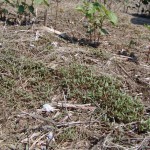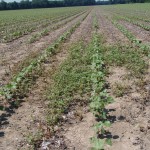
Weed control has become very expensive in many cotton fields. I walked into a number of cotton fields, last week, that from the first burndown to date have close to $100/A in herbicide already applied. Unfortunately, some are not done yet. Part of the issue is the poor residual control in some fields from non-activated post-applied Dual or Warrant(Picture Left). Another issue is in some fields 2 to 6” Palmer amaranth is regrowing after Liberty applications. These herbicide applications were made the week of May 28th when the Palmer was under drought stress and harder to control. I know some folks new to Liberty may assume that if they sprayed smaller Palmer it will be controlled. Liberty is more consistent controlling small Palmer than post-applied PPO herbicides, say in soybean, but it is not as reliable as glyphosate was 10 years ago. There are a number of reasons for this.
One reason for this is coverage. If a few drops of glyphosate just touched Palmer a few years ago it would control it. That is not the case with Liberty on Palmer amaranth.

Typically, Palmer emerges in huge numbers near the mother plant from last year. It can be very difficult to get good coverage in these dense Palmer spots. This is doubly a problem during long drought spells when the Palmer is more hardened off. In these situations many have tried to apply 32 oz/A or more of Liberty and expect complete control. In some cases it will work out that way but in many cases it will not (Picture Right).
In these situations it will take a sequential application within 5 to 10 days to take out the regrowth. Of course there is a lot of concern due to the cost of two 30 some ounce applications. In our research we have gotten better control of Palmer with two planned 29 oz/A applications spaced about 5 days apart than two 30 plus ounce applications spaced greater than 10 days apart.
Another reason is how susceptible Liberty is to being washed off. The label states a 4 hour rain fast period is needed for Liberty to be applied before a rain event. As my colleague Bob Scott in Arkansas would say” it takes every minute of that rain free period before Liberty will control the Palmer amaranth”. A couple of these fields I looked over, I suspect a shower came through inside that 4 hour rain free period as the Palmer was showing little symptoms.
Finally, time of day that Liberty is applied can make a big difference on Palmer control. The best control of Palmer amaranth in our research with Liberty is from applications made mid-morning on until an hour after sunset. Applications made near sunup provided very poor (30 to 50%) Palmer control. Even two applications of 32 oz/A of Liberty applied 14 days apart at 8:30 a.m. only provided about 70% control. Those same applications applied just two hours later (10:30 a.m.) provided 99% control. Research at two locations in Georgia by my colleague Stanley Culpepper saw very similar results (See UGA post).
In Jackson, TN our long term rainfall average for April and May is 12.5” and we only saw 3” this spring. Our 3” of rainfall was a monsoon compared to what some saw in the rest of the state those two months. As a result, many of the Pre applied herbicides or post residual Warrant/Dual applications did not provide much pigweed help. This mandated that producers lean very heavily on Liberty to pick up all the pigweed control virtually alone in a number of fields. Liberty can provide good weed control in these situations. However, it takes more management and care than back in 2003 with Roundup.

